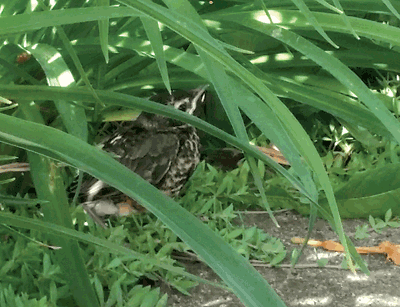FLEDGLING ROBINS JUST OUT OF THE NEST – IT MUST BE SUMMERTIME!
 I heard a robin chirping when I stepped outside one morning earlier this month. It was a young robin, a fledgling I thought, perhaps just out of the nest.
I heard a robin chirping when I stepped outside one morning earlier this month. It was a young robin, a fledgling I thought, perhaps just out of the nest.
An adult robin sang from a tree nearby. A third robin on the ground picked something up from the grass, flew the short distance to the youngster which greeted it with loud chirps and open beak.
Summer time, I thought, as I watched the robins and looked around for more young ones.
I didn’t need the robins to tell me it was summer. The days were long and warm, hot afternoon on days the sky was clear or there were only scattered clouds. Leaves were out on trees and bushes. Our lilac bush was in bloom. The iris and peonies in our flowerbeds had blossoms. Dandelions had gone to seed. Our yard had been mowed, more than once.
Out in the marsh by our pasture, male red-winged blackbirds displayed and sang throughout the day. And in the cattails, I was sure, female redwings incubated eggs or fed nestlings.
The pair of mute swans that occupied our marsh — and had driven Canada geese away — had four cygnets.
The robin is one of the most widely distributed and well known birds of North America. Its nesting range is from the Atlantic Coast to the Pacific, from the Gulf of Mexico into central Canada. Its nesting habitat is around people, in residential areas with trees and lawns, in town and city parks and around country homes.
The robin is a special indicator of the season to many people, including me. As a boy, I watched eagerly for the first robin of the year. It was a sign of the coming spring. The first robin seen, if reported to the editor of the town newspaper, often made the front page.
Then there was the first robin nest of the year, a sign of the coming summer. Spot-breasted young robins on the lawn indicated summer had come. Robins gathering in flocks, deserting lawns and moving to woodlots meant fall was coming. When robins disappeared, I knew they had gone south and that winter was near.
The timing of the seasons has changed, and with it, the timing of the activities of many birds, including robins. Robins don’t migrate south as early in the fall. Some robins don’t go south.
I saw robins near by home in northern Indiana last December and in January and February. I heard robins singing at dawn on mornings when the weather was fair in late February.
Robins, and other birds, are indicators, not just of the changing seasons but of the changing weather and timing of the seasons. When I was young, to see a robin in winter would have been a rare event. Now, though many robins still migrate south for the winter, many more do not.
Robins are listed on Christmas bird counts in many north-central states of the U.S. and even in some northern states. I’ve seen them listed in New York and Michigan and Minnesota.
Some birds have extended their nesting ranges farther north. That’s not true of robins. Robins have always nested to the northern limit of trees in Canada.
But it is true of cardinals. When I was a boy, there were no cardinals in my hometown in northwest Iowa. Now, and for many years, cardinals have nested commonly in that town. Carolina wrens have also extended their range north and pileated woodpeckers.
Birds, it seems, are acting like people, though saying that will get me accused of attributing human actions to other animals.
But while some birds have changed the timing of their activities, some have not. It’s as if some birds have accepted and adapted to living with climate change, global warming, while others, like some people, are climate change deniers.
- Birds As Weather Forecasters – Life In The Outdoors - December 17, 2021
- Rare Bird Spotted In Indiana – Life In The Outdoors - October 8, 2021
- MY EXPERIENCE WITH DEER – Life In The Outdoors - July 30, 2021


